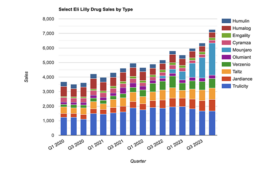|
Turning nanotechnology into a drug delivery system takes more than microscopic particles. Larry Tamarkin, PhD, chief executive officer and co-founder at CytImmune Sciences (Rockville, Md.), says, “I look at nanomedicine as a new drug entity.” This technology depends on nano-sized particles, as well as biological and chemical knowledge of a specific drug and disease.
Tamarkin sees nanomedicine as particularly well-suited for attacking solid tumors. The blood vessels that develop to feed such tumors are leaky, with 200 to 400 nanometer holes that could let engineered chemotherapy reach the tumor, without poisoning the rest of the body. But that requires a range of knowledge. “You must understand how the particles are formed, how the active pharmaceutical ingredient is embedded or attached, and the manufacturing process must be very robust and reproducible,” says Tamarkin.
To meet such demands, CytImmune starts with 27-nanometer, colloidal gold particles and then attaches linear pieces of polyethylene glycol (PEG). PEG hydrates the nanoparticles, which hides them from the immune system but leaves them small enough to get out of leaky vessels. Figuring out this stealth system, though, took lots of work. “We tried over 200 formulations before we found one that avoided the immune system,” Tamarkin says.
CytImmune’s first product, Aurimune, consists of a recombinant version of tumor necrosis factor (TNF) attached to pegylated gold nanoparticles, making the overall size of the drug about 70 nanometers across. Phase 1 trials showed that tumor necrosis factor (TNF) could be given at three times the dose that is toxic without the nanoparticles—presumably because the TNF is only delivered to a tumor rather than the entire body. “TNF is a vascular-disrupting agent,” says Tamarkin, “and it destroys blood vessels that support tumor growth.” CytImmune will soon start Phase 2 trials that combine its TNF-nanomedicine with standard chemotherapies for a variety of cancers.
CytImmune’s second product, AuriTol, binds Taxol and TNF to the pegylated gold nanoparticles. Taxol is a powerful anti-cancer agent, but it also causes hair loss. Limiting Taxol’s biodistribution by attaching it to a nanoparticle might reduce its side effects.
Beyond specific therapies, Tamarkin thinks that nanomedicine could “change the way we treat cancer.” He points out that today’s treatments often start with surgery and then use chemotherapy. “The surgery tears up my roadway, and makes it harder for our drugs to work,” Tamarkin says. If nanomedicine can reduce tumor burdens, the need for surgery could also be reduced. Likewise, nanomedicine could improve other methods of drug delivery.
Extended nano-delivery
|
To make nanomedicine affordable, it pays to utilize existing technology. That’s why NanoMedical Systems (Austin, Texas)makes its drug delivery device with semiconductor manufacturing techniques. Mauro Ferrari, PhD, of the University of Texas Health Science Center at Houston—also a cofounder of NanoMedical—developed this company’s approach to nanomedicine. Starting with silicon, NanoMedical Systems uses semiconductor processing to “bore” hundreds of thousands of nanochannels—typically five to 30 nanometers in diameter with an accuracy of about 0.1 nanometers—in a chip a few millimeters across. “In our design,” says Randy Goodall, NanoMedical’s president and chief executive officer, “the channel is precision-sized a few times larger than the drug molecule.”
Simple diffusion through nanochannels on the chip controls the flow of a drug from an implantable capsule into a patient. A subcutaneous injection will place this capsule—holding one to two milliliters, depending on the drug—under a patient’s skin. There, the capsule will provide continuous release of the drug for months, possibly years.
“We are currently building prototypes,” says Goodall, “and we expect to be on the FDA’s [US Food and Drug Administration] doorstep by late 2009.”
About the Author
Mike May, PhD, is a publishing consultant for science and technology based in Houston, Texas.
This article was published in Drug Discovery & Development magazine: Vol. 12, No. 1, January, 2009, pp. 8-10.
Filed Under: Drug Discovery






